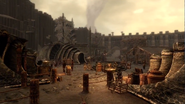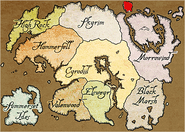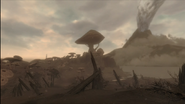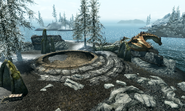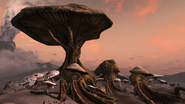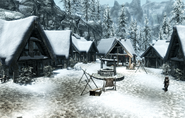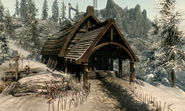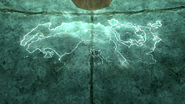- "Therefore, I humbly beseech any students of history who might encounter this modest text to travel to Solstheim and learn all that can be learned of this noble people and their ancient customs. The Skaal people might not be long for this world, but let us assure that their proud and noble legacy lasts well into the future."
- ―Tharstan of Solitude[src]
Solstheim or Soulstheim is an island region located on the Sea of Ghosts, between the provinces of Skyrim and Morrowind. For the longest time, Solstheim held little significance until around 3E 427, when the East Empire Trading Company began to set foot onto the land and build their colony. It has evolved since the disaster in 4E 5, when the High King of Skyrim gave Solstheim to Dark Elven refugees. The Skaal Tribe of Nords have lived on Solstheim since the Merethic Era. It is known as the "Jewel of Absolutely Nothing."
By game
Description
Geography
Felsaad Coast
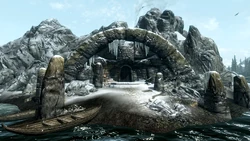
Gyldenhul Barrow is one of the many pirate coves found on Felsaad Coast.
The Felsaad Coast consists of the northeast of Solstheim, and it is the home of the native Nordic population, as the Skaal Village is located on the northeast bluffs. Much of the region has been used by the Skaal Tribe, from not only the village but the subsidiary settlement of the Thirsk Mead Hall, which was founded by a sub-group of the Skaal. The mead hall is found on the other side of the region, on the shores of Lake Fjalding. Minor islands are found on the water, a notable one is the Gyldenhul Barrow, the ancient burial tomb of the infamous Nordic pirate, Haknir Death-Brand. It is found on Horker Island.
Hirstaang Forest

The Hirstaang Forest was obliterated in the Red Year, resulting in a barren Ashland.
The Hirstaang Forest consists of the southern half of Solstheim, and it is the center of the region's commerce, as the settlements of Raven Rock and Fort Frostmoth are found here. Compared to the north, Hirstaang is tame, containing some minor farmlands, outside the Raven Rock walls. Fort Frostmoth was the first settlement in the land, until in 3E 427, the township of Raven Rock was founded. When the Red Year occurred, the sudden ashstorms had practically destroyed the Hirstaang Forest. Fort Frostmoth was swallowed by the ash, and thanks to House Redoran, Raven Rock was able to survive, barely. Dead trees currently riddle the landscape, a shell of its former self.
Isinfier Plains

The Tomb of Vahlok the Jailor is hidden amidst the forests of the Isinfier Plains.
The Isinfier Plains of Solstheim takes the central east of the island, found between the Hirstaang Forest and the Felsaad Coast. The plains are largely barren, as no known settlements can be found here. Only Witches and Reavers live in this region. A small fraction of the Glenmoril Witches live in Isinfier, utilizing the Altar of Thrond as their base of operation. Many natural caverns are found here, such as the Cave of Hidden Music and the Solvjord. In the deep forest lies Vahlok's Tomb, the burial place of the ancient Dragon Priest, Vahlok the Jailor, who faced the Traitor, Miraak in the Merethic Era. Vahlok lives in Skaal culture as "the Guardian."
Moesring Mountains
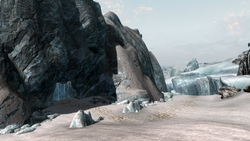
Castle Karstaag was a fortress that housed a legendary Frost Giant named Karstaag.
The Moesring Mountains are the frozen wastes of Solstheim, being found in the northwest, separated by the mountain range by the same name. It is nothing but cold seas of snow, with the occasional cave system, such as Benkongerike and Domme. The only "settlement" in the region is Castle Karstaag, a glacier fashioned into a castle, with dining rooms and long hallways. The Frost Giant, Karstaag lives in the castle. On the northwest, lies the Mortrag Glacier, which engulfs the entire northwest coast. By 4E 5, it was gone and more natural caves were discovered. The Dragon Lair known as Saering's Watch is found overlooking the north.
Fauna
Rieklings & Bristlebacks
Grahl
Ash Creatures
Lurker
Frost Giant
Miscellaneous Creatures
Flora
Government
Religion
History
Merethic Era
The Battle of the Moesring & the Fall of the Snow Prince

The Snow Prince's Ancient Steel Armor & his mighty spear are kept in the catacombs of Jolgeirr Barrow.
- "Like a sudden, violent snow squall that rends travelers blind and threatens to tear loose the very foundations of the sturdiest hall, the Snow Prince did sweep into our numbers. Indeed the ice and snow did begin to swirl and churn about the Elf, as if called upon to serve his bidding. The spinning of that gleaming spear whistled a dirge to all those who would stand in the way of the Snow Prince, and our mightiest fell before him that day."
- ―Lokheim[src]
In the late Merethic Era, the Atmorans under Ysgramor had traveled south to the modern-day lands of Skyrim, building their first city of Saarthal. However, the Snow Elves had besieged the city and drove out the Atmorans in the event known as the Night of Tears. Sometime later, Ysgramor returned to Skyrim and had begun his purge against the Snow Elves in the Nordic-Falmer War, spanning for quite some time. The last known battle was on the region of Solstheim, in the Battle of the Moesring, the last stand of the Falmer. Leading the remaining Falmer is the Snow Prince, the last of the Snow Elven hierarchy. Ysgramor had traveled for Solstheim after devastating the Falmer on the mainland, encountering the remnants of the Snow Elven Army at the Moesring Mountains in the northwest.[1]
In the beginning, the Atmorans were overwhelming the Snow Elves, cutting through them with ease until the arrival of the Snow Prince, who singlehandedly crushed the Atmorans greatly. The Spear of the Snow Prince was legendary for the battle, as it killed various figures, such as Freida Oaken-Wand and Heimdall the Frenzied. Amidst the slaughter, the Snow Prince had killed the mother of a lowly twelve-year-old girl, Finna, a squire to her mother. Enraged, Finna grabbed her mother's sword and pierced it into the Snow Prince's breast. This gave the Atmorans the leeway to ultimately defeat the Snow Elves in Solstheim. This was the end of the elven race's illustrious history, although small remnants took to isolation, never to be heard from. Ysgramor and his chieftain gave the Snow Prince a proper burial, with the exception of Stalhrim, which was reserved for Nords. His burial ground became Jolgeirr Barrow. From then on, the Nords had conquered Solstheim, and eventually, the Dwemer settled in lands far from Nordic cities, resulting in Nchardak and Fahlbtharz.[1][2]
Solstheim's Creation Myth; The Guardian & the Traitor

The battle between Vahlok & Miraak resulted in the land splitting and becoming Solstheim.
- "The Guardian, whom the legend presents as a paragon of loyalty and nobility, finally defeats the despicable Traitor, who seems to represent all that is corrupt and evil in men. Their epic duel is clearly representative of a greater struggle between good and evil. Perhaps it is this timeless quality that has kept the tale alive for so long."
- ―Lucius Gallus[src]
The modern-day Skaal of Solstheim are the descendants of the Dragon Cult that ruled over Solstheim, sometime after Ysgramor's reign, as the Dragon Cult was prominent. One such priest, Miraak, who was the first known Dragonborn, long before the appearance of St. Alessia in Cyrodiil. Miraak had come into contact with Hermaeus Mora, the Daedric Prince of Forbidden Knowledge. The Wretched Abyss had lured Miraak with great knowledge, and the ability to Bend the Will of Dragons, and so he plotted against his Dragon Overlords, killing them in numbers outside his grand temple. Miraak could absorb the Dragon Souls, giving them unbeknownst power that would eventually lead to their downfall. Three Dragon Priests, known as the Acolyte Priests, would follow Miraak and disown the Dragon Cult.[3][4]
The leaders of Bromjunaar had sent the Warrior-Priest, Vahlok to defeat Miraak. The battle between these two forces resulted in the mainland splitting, and that broken piece of land became modern-day Solstheim. In an epic battle between good and evil, the two priests had battled until Vahlok had emerged victorious. The Acolyte Priests were defeated, from Ahzidal to Zahkriisos. While other tales would end it here, the truth is different. Before Vahlok would kill him, Miraak withdrew into Apocrypha, while Vahlok the Guardian stays vigilant for his return. The Tale of the Guardian & the Traitor became a cautionary tale to the Skaal Tribe, as a warning for the inevitable return. Vahlok became the ruler of Solstheim, and the Dragon Cult of Solstheim remained isolated from the rest, resulting in their transformation into the modern-day Skaal.[3]
Second Era
Records of Solstheim throughout the Years

The Skaal Village & Thirsk were the only settlements on Solstheim (before Fort Frostmoth or Raven Rock).
- "After meeting King Logrolf, I took the time to examine a display of clothing from the many subcultures of Skyrim, which it seems is home to other peoples than just those mainstream Nords so well-known across northern Tamriel. But I also came across the clothing of a culture previously unknown to me, that of the Skaal, who inhabit an island in the Sea of Ghosts named Solstheim (I hope I've spelled that right—my notes were taken in haste)."
- ―Doctor Alfidia Lupus[src]
Solstheim's history since the Dragon Cult is largely unknown, but it has appeared in history since the Merethic Era, and before even Tiber Septim's rise to power. Despite the Skaal's isolation, they are acknowledged by the government of Skyrim, as High King Logrolf, who was alive during the reign of Versidue Shaie, had a set of Stalhrim Armor on display, courtesy of the Skaal. The island of Solstheim was considered a territory of Skyrim, ever since the Battle of the Moesring, and so it has been used by the province, but it did not have a known centralized settlement like the East Empire Trading Company had with Fort Frostmoth. Because of how unpopulated Solstheim is, many people took to the island for a private retreat, where one scholar lived in White Ridge Barrow to conduct experiments on explosive, elemental spiders. With the schism that had befallen onto Skyrim, it is unknown which kingdom claimed Solstheim but considering its location; it was likely claimed by the Eastern Kingdom. It was unharmed, nor utilized by the invading Kamali Army in the Second Akaviri Invasion, as they bypassed the island and headed straight for Windhelm. Second Era cartography has depicted Solstheim among other the other provinces, in the seas shared by Skyrim and Morrowind, but as the time went on, the island of Solstheim had become forgotten until in the late Third Era.[5][6][7][8][9]
Third Era
- Main article: Solstheim (Bloodmoon)
Hrothmund the Red & Thirsk Mead Hall
The East Empire Trading Company & Raven Rock
The Bloodmoon Prophecy & the Will of Hircine
Solstheim in the Waning Third Era
Fourth Era
- Main article: Solstheim (Dragonborn)
The Red Year & Morrowind's Expansion
Elhul Sathil & the Cursed Blade, Umbra
The Colony of Raven Rock & Vilur Ulen's Plot
The Temple of Miraak & the Corrupted Stones
Miraak's Downfall; At the Summit of Apocrypha
The Revival of Raven Rock; the Second Golden Age
Locations
Regions
- Felsaad Coast
- Hirstaang Forest (Solstheim Ashlands)
- Isinfier Plains
- Moesring Mountains
Settlements
- Raven Rock
- Bujold's Retreat
- Fort Frostmoth (Settlement)
- Haknir's Shoal
- Northshore Landing
- Old Attius Farm
- Oleen Mar
- Ramshackle Trading Post
- Sathil
- Skaal Village
- Tel Mithryn
- Thirsk Mead Hall
Ruins
- Ashfallow Citadel
- Bloodskal Barrow
- Connorflenge Barrow
- Eddard Barrow
- Fahlbtharz
- Fort Frostmoth (Ruins)
- Frosselmane Barrow
- Glenschul's Tomb
- Gyldenhul Barrow
- Highpoint Tower
- Himmelhost Barrow
- Hrothmund's Barrow
- Jolgeirr Barrow
- Kagrumez
- Kelsedolk Barrow
- Kolbjorn Barrow
- Lukesturm Barrow
- Morvayn Ancestral Tomb
- Nchardak
- Patchwork Airship
- Skogsdrake Barrow
- Snowclad Ruins
- Stormpfund Barrow
- Tombs of Skaalara
- Ulen Ancestral Tomb
- Vahlok's Tomb
- Valbrandr Barrow
- White Ridge Barrow
Caves
- Benkongerike
- Bjorn
- Bristleback Cave
- Broken Tusk Mine
- Caves of Fjalding
- Cave of Hidden Music
- Coldcinder Cave
- Damphall Mine
- Domme
- Fjell
- Frossel
- Frostmoon Crag
- Frykte
- Gandrung Caverns
- Glacial Cave
- Gloomy Cave
- Gronn
- Halls of Penumbra
- Lair of the Udyrfrykte
- Legge
- Rimhull
- Sjobal
- Skygge
- Solvjord
- Stahlman's Gorge
- Varstaad Caves
Landmarks
- Altar of Thrond
- Beast Stone
- Brodir Grove
- Castle Karstaag
- Earth Stone
- Ensleth Valley
- Harstrad River
- Horker Island
- Hrothmund's Bane
- Hvitkald Peak
- Iggnir River
- Isild River
- Lake Fjalding
- Mortrag Glacier
- Mount Moesring
- Saering's Watch
- Sea of Ghosts
- Stalhrim Source
- Sun Stone
- Thormoor's Watch
- Tree Stone
- Water Stone
- Wind Stone
Gallery
Trivia
- In An Elder Scrolls Novel: The Infernal City the island is referred as Soulstheim. It is probably an error of the author, since he uses the habitual name Solstheim for An Elder Scrolls Novel: Lord of Souls.
Appearances
- The Elder Scrolls III: Morrowind (mentioned only)
- The Elder Scrolls IV: Oblivion (mentioned only)
- An Elder Scrolls Novel: The Infernal City (mentioned only)
- An Elder Scrolls Novel: Lord of Souls
- The Elder Scrolls V: Skyrim (mentioned only)
- The Elder Scrolls Online (mentioned only)
References
- ↑ 1.0 1.1 Fall of the Snow Prince
- ↑ Diary of Faire Agarwen
- ↑ 3.0 3.1 The Guardian and the Traitor
- ↑ Dialogue from "Tharstan"
- ↑ Crafting Motif 46: Stalhrim Frostcaster Style
- ↑ The Second Akaviri Invasion
- ↑ Dialogue from "Lady Clarisse Laurent"
- ↑ Events of The Elder Scrolls Online
- ↑ Map of Tamriel & the Alliance Core Regions
| Morrowind Locations in Lore | |
|---|---|
| Cities | Ald'ruhn • Balmora • Blacklight • Brass Fortress • Ebonheart • Firewatch • Kragenmoor • Mournhold • Narsis • Necrom • Port Telvannis • Sadrith Mora • Tear • Vivec City |
| Regions | Bal Foyen • Clockwork City • Dejayste • Deshaan • Stonefalls • Telvanni Peninsula • Thornmarsh • Vvardenfell (Miscellaneous: Gorne • Solstheim • Northeast Archipelago) |
| Landmarks | Bamz-Amschend • Brothers of Strife • Cavern of the Incarnate • Ghostgate • Holamayan Monastery • Inner Sea • Kogoruhn • Mournhold Temple • Red Mountain • Shrine of Saint Veloth • Vivec's Antlers |


